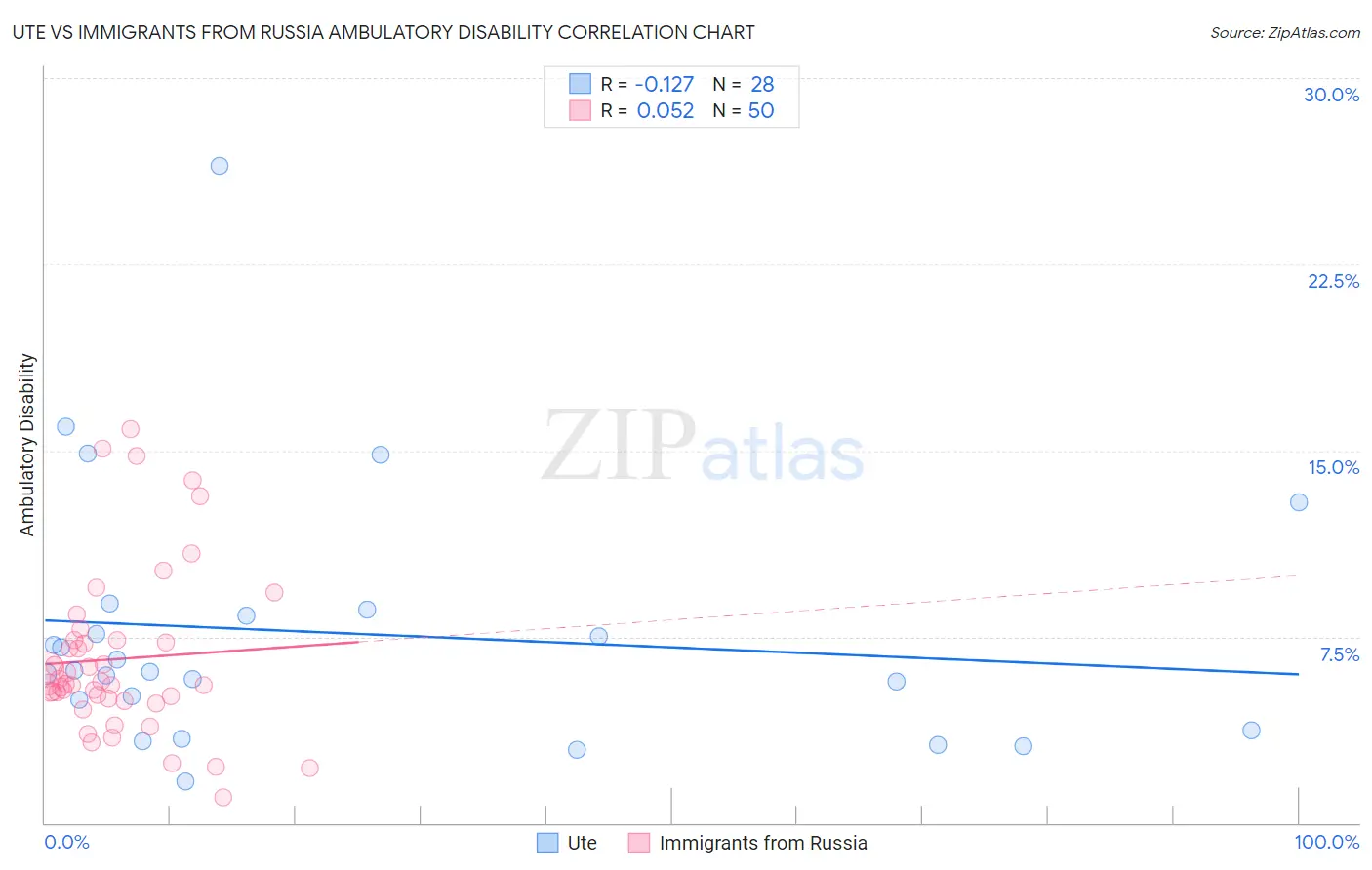Ute vs Immigrants from Russia Ambulatory Disability
COMPARE
Ute
Immigrants from Russia
Ambulatory Disability
Ambulatory Disability Comparison
Ute
Immigrants from Russia
6.0%
AMBULATORY DISABILITY
86.6/ 100
METRIC RATING
134th/ 347
METRIC RANK
5.9%
AMBULATORY DISABILITY
92.4/ 100
METRIC RATING
123rd/ 347
METRIC RANK
Ute vs Immigrants from Russia Ambulatory Disability Correlation Chart
The statistical analysis conducted on geographies consisting of 55,667,207 people shows a poor negative correlation between the proportion of Ute and percentage of population with ambulatory disability in the United States with a correlation coefficient (R) of -0.127 and weighted average of 6.0%. Similarly, the statistical analysis conducted on geographies consisting of 347,844,445 people shows a slight positive correlation between the proportion of Immigrants from Russia and percentage of population with ambulatory disability in the United States with a correlation coefficient (R) of 0.052 and weighted average of 5.9%, a difference of 0.87%.

Ambulatory Disability Correlation Summary
| Measurement | Ute | Immigrants from Russia |
| Minimum | 1.7% | 1.0% |
| Maximum | 26.5% | 15.9% |
| Range | 24.8% | 14.8% |
| Mean | 7.6% | 6.6% |
| Median | 6.1% | 5.6% |
| Interquartile 25% (IQ1) | 4.3% | 5.0% |
| Interquartile 75% (IQ3) | 8.5% | 7.4% |
| Interquartile Range (IQR) | 4.1% | 2.4% |
| Standard Deviation (Sample) | 5.2% | 3.3% |
| Standard Deviation (Population) | 5.1% | 3.3% |
Demographics Similar to Ute and Immigrants from Russia by Ambulatory Disability
In terms of ambulatory disability, the demographic groups most similar to Ute are Immigrants (6.0%, a difference of 0.040%), Immigrants from Europe (6.0%, a difference of 0.15%), Immigrants from Italy (6.0%, a difference of 0.18%), Immigrants from North Macedonia (6.0%, a difference of 0.27%), and Immigrants from Syria (6.0%, a difference of 0.27%). Similarly, the demographic groups most similar to Immigrants from Russia are Costa Rican (5.9%, a difference of 0.020%), Icelander (5.9%, a difference of 0.020%), Immigrants from Middle Africa (5.9%, a difference of 0.040%), Estonian (5.9%, a difference of 0.10%), and Norwegian (5.9%, a difference of 0.13%).
| Demographics | Rating | Rank | Ambulatory Disability |
| Russians | 93.4 /100 | #118 | Exceptional 5.9% |
| Norwegians | 93.1 /100 | #119 | Exceptional 5.9% |
| Estonians | 92.9 /100 | #120 | Exceptional 5.9% |
| Costa Ricans | 92.6 /100 | #121 | Exceptional 5.9% |
| Icelanders | 92.6 /100 | #122 | Exceptional 5.9% |
| Immigrants | Russia | 92.4 /100 | #123 | Exceptional 5.9% |
| Immigrants | Middle Africa | 92.2 /100 | #124 | Exceptional 5.9% |
| Koreans | 91.6 /100 | #125 | Exceptional 5.9% |
| Arabs | 91.5 /100 | #126 | Exceptional 5.9% |
| Immigrants | Nigeria | 90.9 /100 | #127 | Exceptional 5.9% |
| Immigrants | Western Asia | 90.7 /100 | #128 | Exceptional 5.9% |
| Immigrants | Norway | 90.5 /100 | #129 | Exceptional 5.9% |
| Immigrants | Kazakhstan | 89.7 /100 | #130 | Excellent 5.9% |
| Immigrants | Costa Rica | 89.5 /100 | #131 | Excellent 5.9% |
| Immigrants | Europe | 87.8 /100 | #132 | Excellent 6.0% |
| Immigrants | Immigrants | 86.9 /100 | #133 | Excellent 6.0% |
| Ute | 86.6 /100 | #134 | Excellent 6.0% |
| Immigrants | Italy | 85.0 /100 | #135 | Excellent 6.0% |
| Immigrants | North Macedonia | 84.1 /100 | #136 | Excellent 6.0% |
| Immigrants | Syria | 84.1 /100 | #137 | Excellent 6.0% |
| Immigrants | Hungary | 83.9 /100 | #138 | Excellent 6.0% |